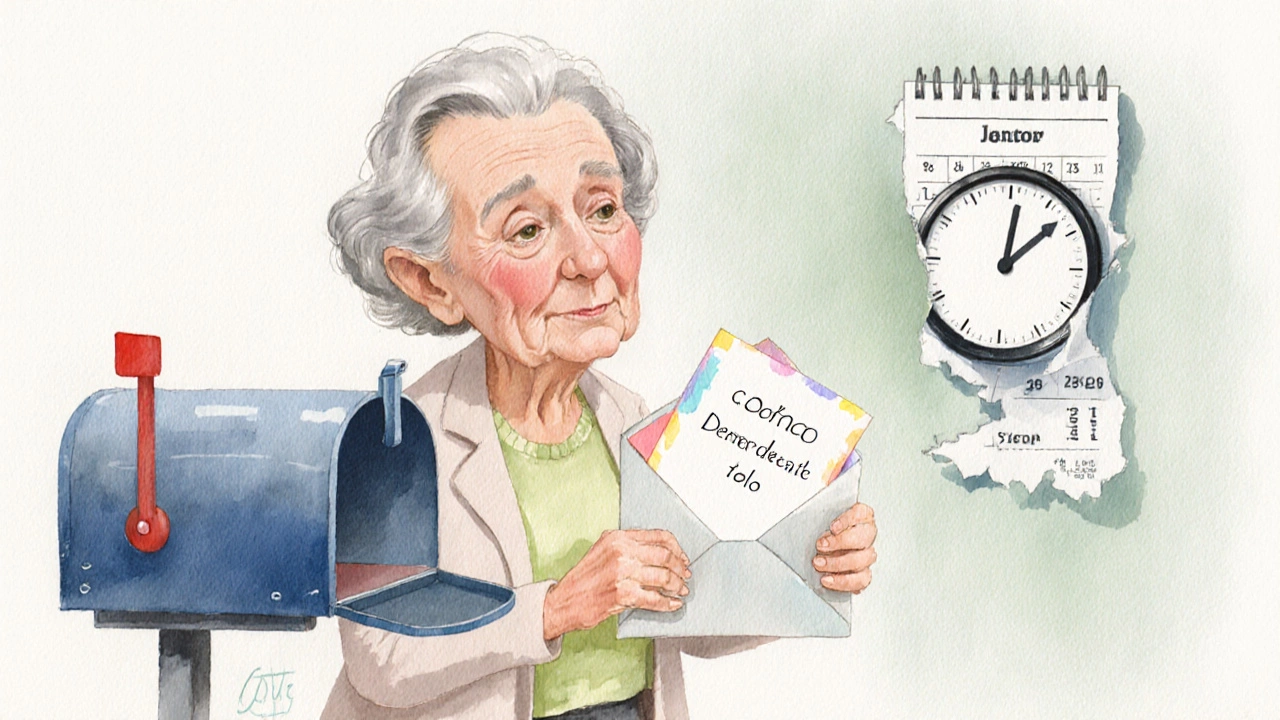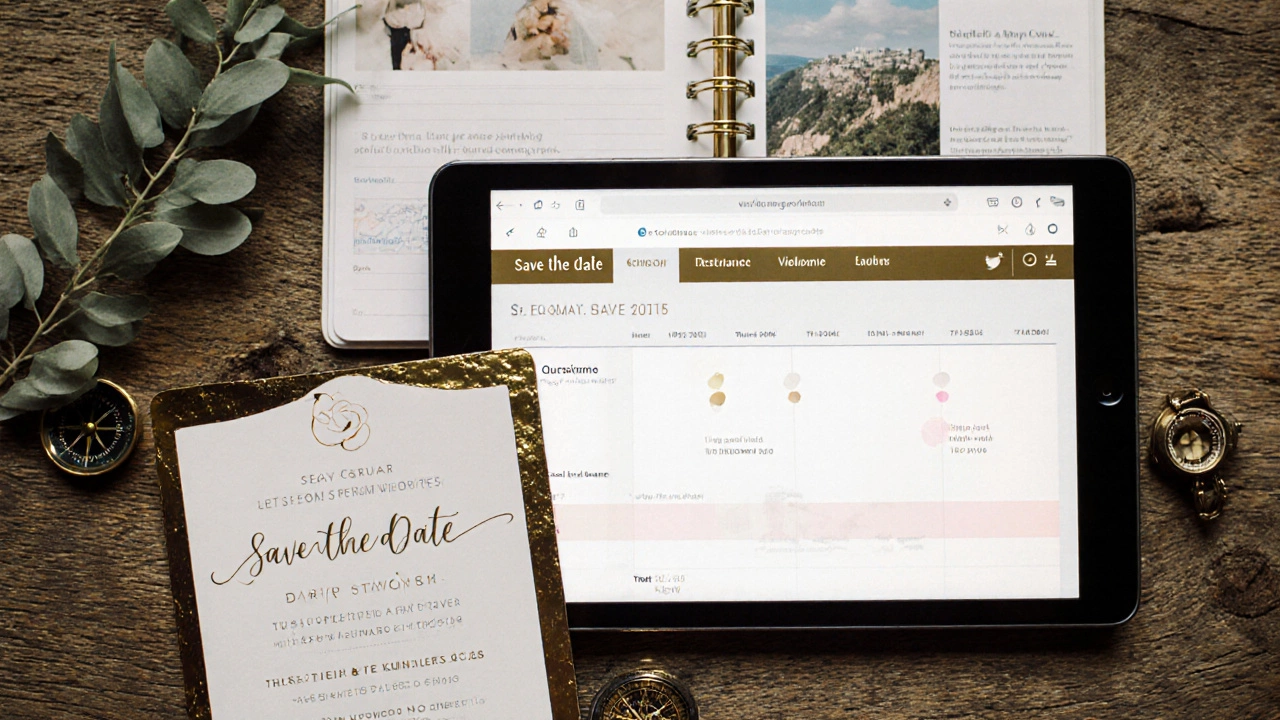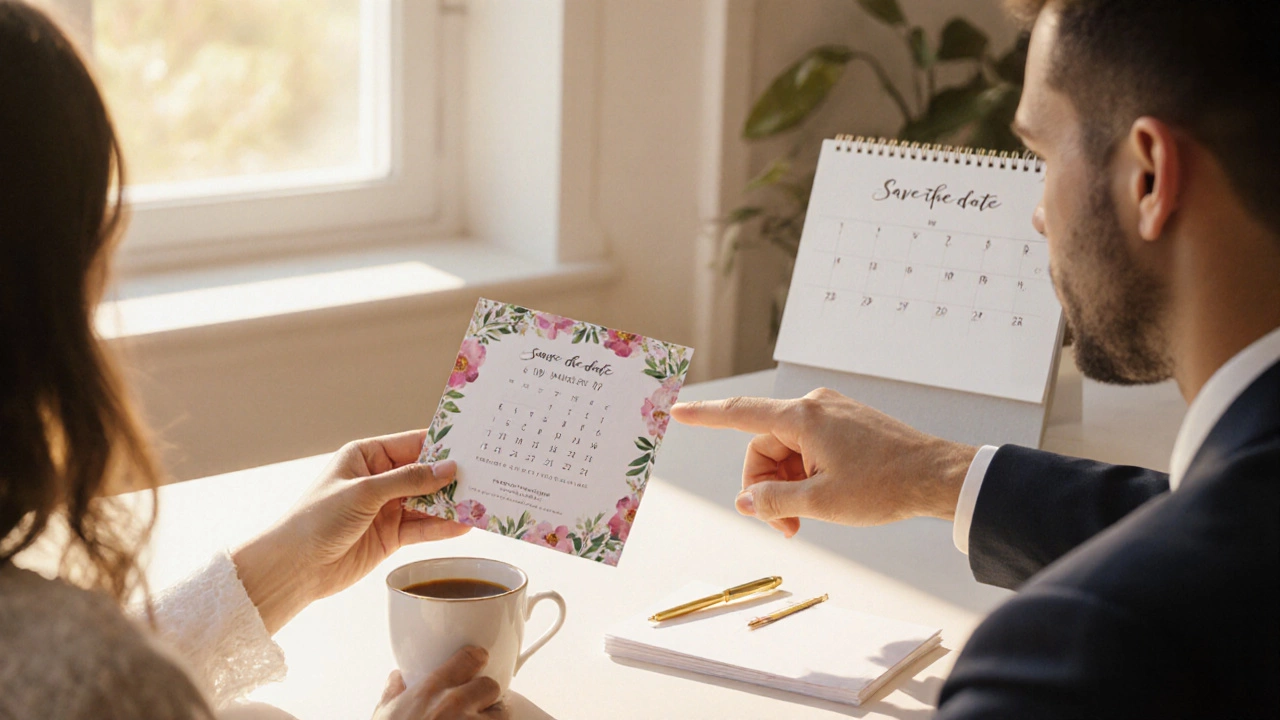Wedding Save-the-Date Timing Calculator
Calculate Your Wedding Timeline
Determine the ideal timing for your save-the-date and formal invitation based on your wedding details.
When planning a wedding, Save the date is a brief notice sent to guests months in advance to announce the wedding date and location. It’s meant to give people a heads‑up so they can block the calendar, especially when travel or holidays are involved. But what happens when that the only card you send? Is it rude, or just a modern shortcut?
What a Save‑the‑Date Actually Does
A save‑the‑date card, whether printed on glossy cardstock or delivered as a sleek email, serves three main purposes:
- Timing: Let guests know the date far enough ahead to arrange flights, accommodation, or time off work.
- Location hint: Usually includes the city or venue name so guests can start budgeting for travel.
- Formal tone cue: Signals that a traditional invitation will follow, setting the expectation for a formal event.
Because it’s short and informal, many couples treat it like a friendly reminder rather than the official invite.
Traditional Etiquette Rules
Etiquette experts, from the Emily Post Institute to Australian wedding planner blogs, have long agreed on a few baseline rules:
- Send the save‑the‑date at least six to eight months before the wedding if it’s a destination or holiday‑season ceremony.
- Follow the save‑the‑date with a formal invitation no later than three months before the big day.
- Include all guests on the save‑the‑date who will receive a formal invitation later.
Following these steps keeps the communication clear and avoids any perception of rudeness.
When Skipping the Formal Invitation Looks Rude
Not every couple will have the luxury of sending both cards. However, certain scenarios can make guests feel overlooked:
- Short lead‑time: If you send a save‑the‑date only a month before the wedding, it looks like you’re trying to cut corners.
- Informal vibe: A hands‑off save‑the‑date that says “Details to follow” without a subsequent invitation can leave guests guessing.
- Selective guest list: Sending a save‑the‑date to only half the guests (e.g., close family) but not the others may feel exclusionary.
In these cases, the lack of a formal invitation can be interpreted as dismissive, especially among older relatives who expect traditional paper invites.

How to Phrase a Save‑the‑Date to Keep It Polite
Wording matters. A well‑crafted save‑the‑date can signal that a formal invitation is on its way, easing any concerns. Here are some proven templates:
- “We’re tying the knot! Please save the date for our wedding on 12 May 2026 in Sydney. Formal invitation to follow.”
- “Mark your calendar - we’re getting married on 23 September 2026. Full details coming shortly.”
- “Save the date! We’ll be celebrating our wedding on 5 December 2026 at the Sydney Opera House. Invitation to follow.”
Including a clear “invitation to follow” line reassures guests that they’ll receive all the necessary logistics later.
Alternative Ways to Keep Guests Informed
If budget or time constraints make a printed invitation impractical, consider these modern alternatives while still respecting etiquette:
- Digital invitation platforms: Services like Paperless Post or Greenvelope let you send beautifully designed e‑invites that include RSVP tracking.
- Wedding website: Create a site (e.g., www.smiths-wedding.com.au) that hosts the full invitation, travel info, registry links, and a built‑in RSVP form.
- Hybrid approach: Send a printed save‑the‑date, then follow up with an email invitation three months out.
Whichever route you choose, make sure the final invitation includes all critical details: dress code, ceremony start time, reception venue, and RSVP deadline.
Checklist & Timeline: When to Send What
| Milestone | When to Send | Key Content |
|---|---|---|
| Engagement announcement | Immediately after proposal | Personal news, no formal cards needed |
| Save‑the‑Date | 6-8 months before wedding (or 4 months for destination) | Date, city/venue, “Invitation to follow” line |
| Formal Invitation | 12-14 weeks before wedding (latest 8 weeks) | Full details, RSVP card or link, dress code |
| Reminder Email | 2 weeks before RSVP deadline | Polite nudge, link to RSVP page |
| Final Details | 1 week before ceremony | Directions, parking, contact info |
Sticking to this schedule helps you avoid the perception of rudeness while keeping everything organized.

Common Mistakes and How to Fix Them
- Leaving out the RSVP deadline: Guests need a clear cut‑off date. Add a line like “Please RSVP by 15 March 2026.”
- Sending the save‑the‑date to the wrong address: Double‑check mailing lists; a mis‑addressed card can cause embarrassment.
- Using vague wording: “Date may change” raises anxiety. If the date isn’t set, wait until it is.
- Skipping the invitation entirely: If you must, upgrade the save‑the‑date to a full invitation with all details; just rename it as the official invite.
Real‑World Example: An Australian Wedding
Emily and Liam, a couple from Sydney, booked a vineyard in the Hunter Valley for a spring wedding. They sent a printed save‑the‑date in November 2025 (7 months ahead) that read:
“Emily & Liam are getting married! Please save the date: Saturday, 15 May 2026, Hunter Valley. Formal invitation to follow.”
Two months later, they emailed a beautifully designed digital invitation with RSVP links, dress code (semi‑formal), and accommodation suggestions. Their guests praised the clear timeline and felt fully included, showing that a well‑timed save‑the‑date is never rude when followed by a proper invitation.
Quick Takeaways
- Save‑the‑date is a courtesy, not a replacement for an invitation.
- Send it 6-8 months early for local weddings, 4 months for destination events.
- Always add a line promising a formal invitation.
- Follow up with a full invitation 12-14 weeks before the ceremony.
- If you skip the paper invite, use a digital platform that includes all details and RSVP.
Can I send only a digital save‑the‑date and no paper invitation?
Yes, as long as the digital save‑the‑date clearly states that a full invitation (digital or paper) will follow. Include all essential details and a clear RSVP deadline to keep the etiquette intact.
What if I forget to send the formal invitation?
Apologize promptly, then send the invitation immediately-preferably with an extra note explaining the delay. Most guests will understand if you’re transparent.
Is it okay to send a save‑the‑date to distant relatives but not to close friends?
It can feel inconsistent. The safest approach is to send the same save‑the‑date to everyone who will receive an invitation, then tailor any additional personal notes separately.
Do I need to include the exact venue on the save‑the‑date?
Listing the city or region is enough. Full venue details belong on the formal invitation, where you can also provide parking and accommodation info.
How far in advance should I ask guests to RSVP?
Set the RSVP deadline roughly 4-6 weeks before the wedding. This gives you time to finalize headcounts for catering and seating.
